
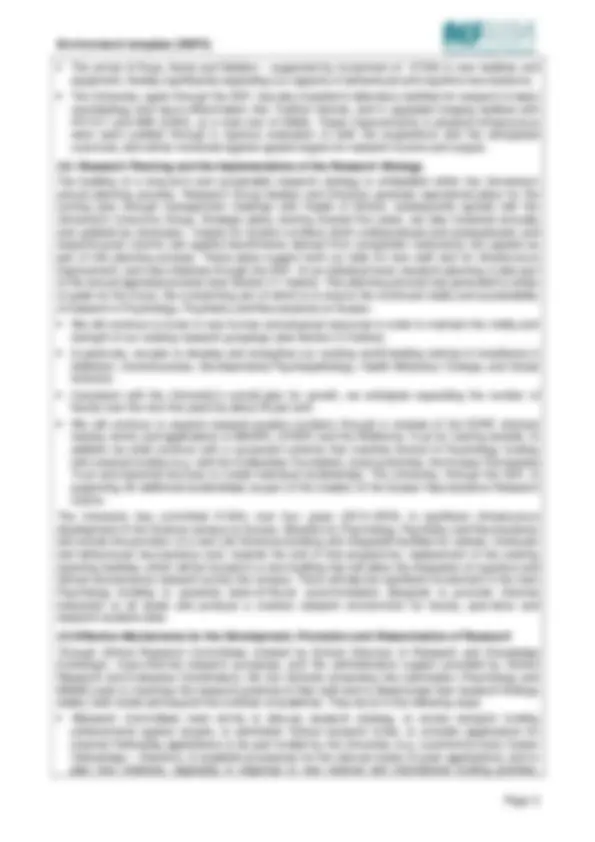
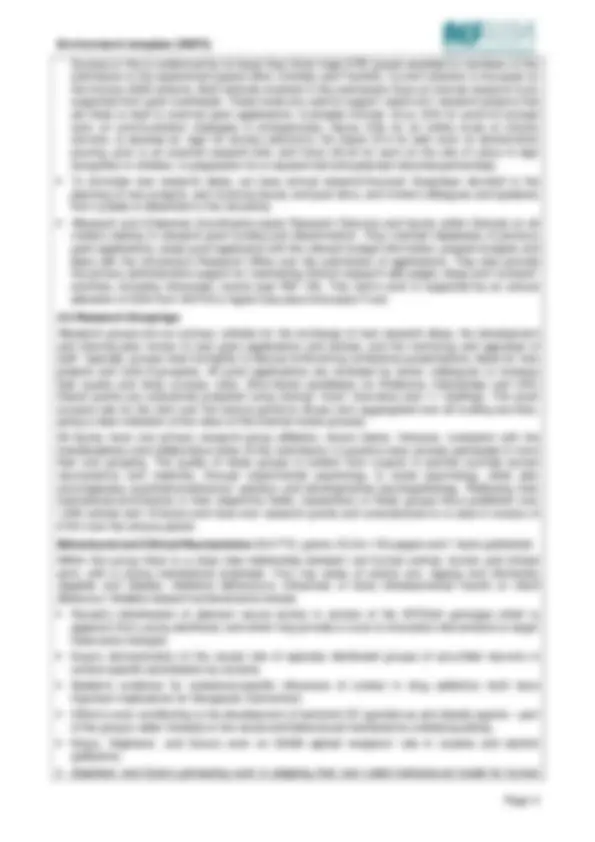
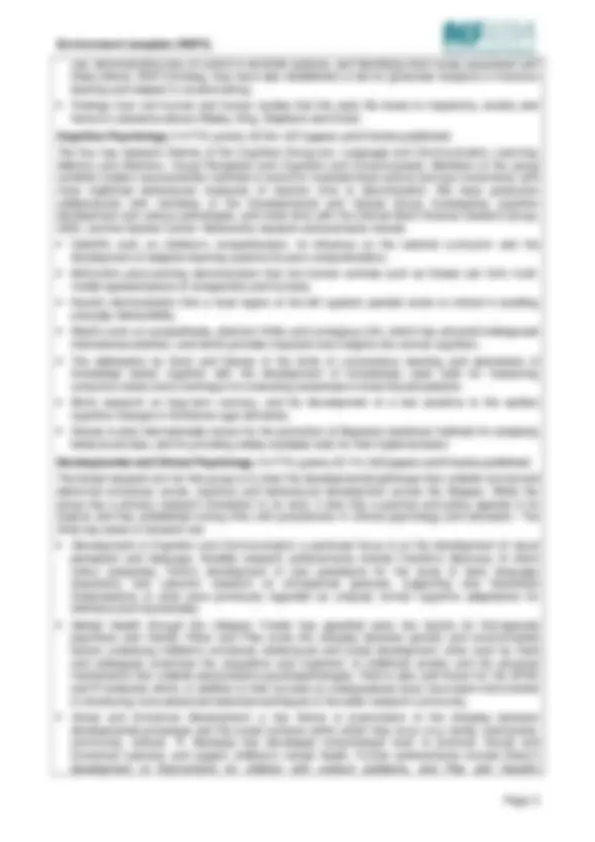
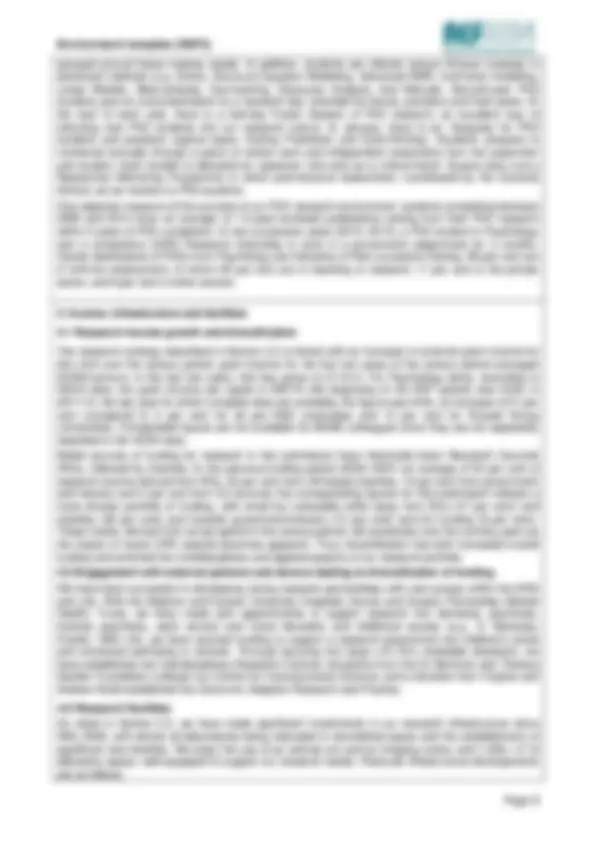
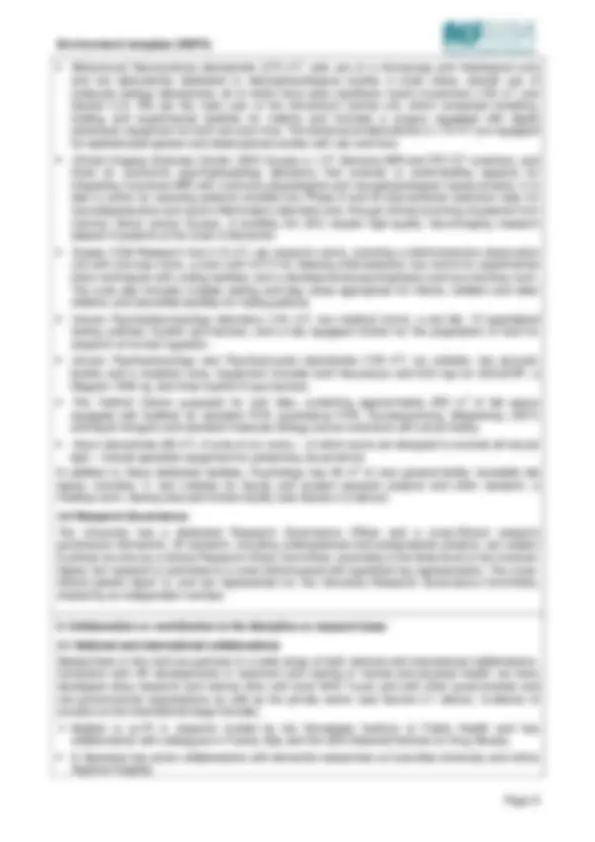
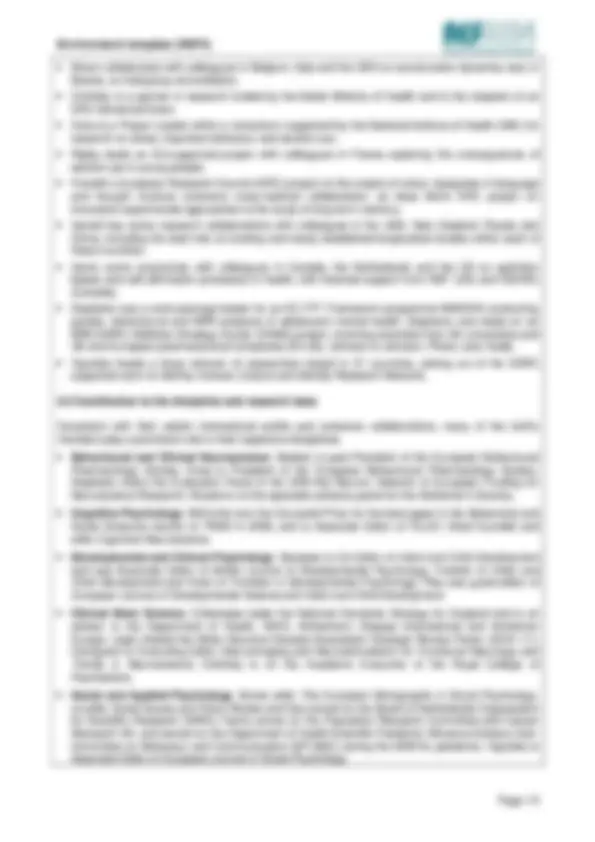


Study with the several resources on Docsity

Earn points by helping other students or get them with a premium plan


Prepare for your exams
Study with the several resources on Docsity

Earn points to download
Earn points by helping other students or get them with a premium plan
Community
Ask the community for help and clear up your study doubts
Discover the best universities in your country according to Docsity users
Free resources
Download our free guides on studying techniques, anxiety management strategies, and thesis advice from Docsity tutors
The University of Sussex's Developmental and Clinical Psychology group focuses on translating research in human development to clinical, policy and public contexts. They have implemented a four-pronged research strategy including targeted staff recruitment, engagement with external partners, inter-disciplinary collaborations, and enhancement of the research environment. Notable achievements include the establishment of new research centres, collaborative research and training ventures, and investment in laboratory facilities. Research covers areas such as mental health through the lifespan, group and intergroup processes, and behavioural and cognitive neuroscience.
Typology: Study notes
1 / 10

This page cannot be seen from the preview
Don't miss anything!







Institution: University of Sussex
Unit of Assessment: UoA 4 Psychology, Psychiatry and Neuroscience
1. Overview
Psychology, Psychiatry and Neuroscience at Sussex combine cutting-edge, discovery-oriented research and strong engagement with policy-makers in health and social care, non-governmental organisations and the private sector. In this way we tackle contemporary challenges in mental and physical health, social inclusion and well-being.
This submission brings together five research groups, four in the School of Psychology and one in the Brighton and Sussex Medical School (BSMS):
Cross-School and cross-university research centres facilitate interactions between these research groups and with other researchers in the University. Such centres are established to nurture new research activity, build more effectively on areas of academic strength and enhance the vitality of our research environment. They run research colloquia and facilitate shared access to important research populations (e.g. clinical samples, children and young people, participants in disasters and emergencies) and major items of equipment. The seven centres relevant to this submission are:
Psychology and the BSMS have worked closely together since the RAE 2008 in order to achieve five
aims, the first four of which were explicitly stated in the Psychology 2008 submission:
To achieve the above aims we have implemented a four-pronged research strategy:
2.1. The Research Environment
The overall result of our research strategy has been a significant enrichment of the research environment, with new appointments, collaborative research and training ventures with the SPT and Local Authorities (LAs), four new Research Centres (Sussex Neuroscience, Sussex Addiction, Sackler and Rudd), substantial new research collaborations, and a growth and diversification of research income (see 4.1 below).
Targeted staff recruitment. Natural staff mobility in Psychology and the BSMS has provided the opportunity to make outstanding new appointments. In these, we have consolidated our strengths in addiction (Badiani, Koya), extended our expertise in cognitive neuroscience (Bird, Kanai, Forster), branched out in new directions in clinical (Fowler) and developmental psychology (Franklin, Harold, Oliver, Gaysina), enhanced existing strengths in health psychology (Harris, Miles), and developed new streams of activity in clinical brain science (S. Banerjee, Cercignani, Leigh and Sigala). Each research group has sufficient research-active faculty to ensure critical mass. Importantly, these new colleagues are already developing collaborations across School and Unit boundaries (e.g., Bird and Chan; Dowell, Tabet and Rusted), following the lead of existing joint research projects (e.g., Brown with Walters (Law), Collyer (Global Studies) and Morrice (Education); Duka and Critchley; Leigh and Chan with Hafezparast and Caledcott (Life Sciences); Dienes, Ward, Critchley and Seth (Sackler)).
Specific changes to the research environment. Recent enhancements include:
Success in this is evidenced by no fewer than three major ERC grants awarded to members of this submission in the assessment period (Bird, Critchley and Franklin). Current attention is focussed on the Horizon 2020 scheme. Both Schools involved in this submission have an internal research fund, supported from grant overheads. These funds are used to support ‘seed-corn’ research projects that are likely to lead to external grant applications. Examples include: Drury (£3k for proof-of-concept work on communication strategies in emergencies); Davey (£3k for an online study of chronic worriers, to develop an ‘app’ for anxiety reduction); De Visser (£1k for pilot work on alcohol-drink pouring, prior to an external research bid); and Horst (£2.5k for work on the role of colour in digit recognition in children, in preparation for a research bid and potential industrial partnership).
2.4 Research Groupings
Research groups are our primary vehicles for the exchange of new research ideas, the development and informal peer review of new grant applications and articles, and the mentoring and appraisal of staff. Typically, groups meet fortnightly to discuss forthcoming conference presentations, ideas for new projects and work-in-progress. All grant applications are reviewed by senior colleagues to increase their quality and likely success rates. Short-listed candidates for Wellcome Fellowships and ERC Starter grants are extensively prepared using internal ‘mock’ interviews and 1:1 briefings. The grant success rate for the UoA over the census period is 38 per cent (aggregated over all funding sources), giving a clear indication of the value of this internal review process.
All faculty have one primary research-group affiliation, shown below. However, consistent with the interdisciplinary and collaborative ethos of this submission, in practice many actively participate in more than one grouping. The quality of these groups is evident from outputs in premier journals across neuroscience and medicine, through experimental psychology to social psychology, while also encompassing quantitative-behaviour genetics and developmental psychopathology. Reflecting their international prominence in their respective fields, researchers in these groups have published over 1,000 articles and 18 books and have won research grants and consultancies to a value in excess of £14m over the census period.
Behavioural and Clinical Neuroscience (9.6 FTE; grants, £3.2m; 155 papers and 1 book published)
Within this group there is a close inter-relationship between non-human animal, human and clinical work, with a strong translational emphasis. Four key areas of activity are: Ageing and Dementia ; Appetite and Obesity ; Addictive Behaviours ; Influences of Early Developmental Insults on Adult Behaviour. Notable research achievements include:
use, demonstrating loss of control in alcoholic patients, and identifying brain areas associated with these effects. With Crombag, they have also established a role for glutamate receptors in incentive learning and relapse to cocaine taking;
Cognitive Psychology (14 FTE; grants, £2.9m; 227 papers and 6 books published)
The four key research themes of the Cognitive Group are: Language and Communication , Learning, Memory and Attention , Visual Perception and Cognition and Consciousness. Members of the group combine modern neuroscientific methods to record or modulate brain activity and eye movements, with more traditional behavioural measures of reaction time or discrimination. We have productive collaborations with members of the Developmental and Clinical Group investigating cognitive development and various pathologies, and close links with the Clinical Brain Science research group, CISC, and the Sackler Centre. Noteworthy research achievements include:
Developmental and Clinical Psychology (14 FTE; grants, £2.7m; 222 papers and 6 books published)
The broad research aim for this group is to chart the developmental pathways that underlie normal and abnormal emotional, social, cognitive and behavioural development across the lifespan. While the group has a primary research orientation to its work, it also has a practice and policy agenda in its outputs and has established strong links with practitioners in clinical psychology and education. The three key areas of research are:
3.1 Staffing strategy and staff development
Consistent with our research strategy (see Section 2 above), we aim for all faculty to be active researchers, capable of achieving an international reputation. We have a policy of recruiting junior staff to ensure the long-term sustainability of research groups. Of the 21 appointments made since January 2008, 16 have not held a previous permanent faculty position. The recruitment of senior staff has also been a strategic priority to provide research leadership in particular areas (e.g. Badiani, S. Banerjee, Fowler, Harris, Harold). Teaching and research faculty are appraised annually by a senior faculty member. Appraisal reports are passed to the HoS, who then responds to action points in these reports. New and postdoctoral staff are also assigned a mentor, normally an established colleague in their research group, with whom they discuss career-development issues and progress towards the satisfactory completion of probation.
The University has established a Doctoral School to work with senior academic staff, especially Principal Investigators, to ensure that the interests of research staff early in their research careers, as well as research students, are institutionally represented. It’s aims are to:
Staff development budgets support both full-time teaching faculty and research staff in individual activities, such as attendance on courses and School activities, including at least one research ‘ Awayday ’ per year. We also mount courses to develop research skills and run workshops on structural equation modelling, multilevel modelling, web-based technology for surveys, the use of experiment generators such as E-Prime, and the design and analysis of fMRI experiments. The University has implemented the ‘ Concordat to Support Career Development of Researchers ’, thus ensuring that research staff receive appropriate mentoring and appraisal from line-managers or senior colleagues. Contributing Schools to this UoA have Equalities Groups that monitor patterns of staff recruitment, promotion and study-leave allocation and assist in the development of ‘family-friendly’ working practices. These groups also lead on School-based applications for Athena Swan accreditation.
There has been a deliberate policy of engagement with local NHS partners. This has borne fruit in high-profile joint appointments with SPT to lead research in dementia (S. Banerjee) and child and young people’s mental health (Fowler), and NHS Visiting Research Fellows to develop research on early intervention in psychosis (Greenwood, Hayward).
3.2 Research students
We have a thriving community of 83 PhD students (Psychology, 81; BSMS, 2), selected from a competitive field (typically, ~80 applicants per annum). In the census period, 73 students successfully completed a PhD. Our major sources of PhD funding are BBSRC and ESRC, for which Sussex received a Doctoral Training Centre (DTC) award, one of 12 single-site DTCs in the UK, and Psychology takes around 5 ESRC students annually. The other RCs (MRC, EPSRC) and charities (Wellcome, Alzheimer’s Trust, Breast Cancer Campaign) collectively make up the remaining studentships. In addition, the University funds Graduate Teaching Assistantships (GTAs) – typically about 8 per annum across the UoA. These may be the sole source of funding for some students, but are typically used on a match-funded basis either for RC studentships or for ‘third-stream’ funding, which is particularly attractive to external partners (costs are split ~50/50). We have secured 9 CASE studentships since 2008, including 3 with BBSRC (partners: Eli Lilly, Johnson & Johnson, Leatherhead Food Research), 2 with the ESRC (partners: SPT), and 1 with the Centre for Team Excellence. We also attract students on overseas government scholarships (typically 2–3 per annum).
All students are allocated a main and a secondary supervisor from appropriate faculty in each research group. There is a strong emphasis on skills training. At the start of each academic year, students are required to complete a Training Needs Analysis ( Vitae Researcher Development Framework) in which they assess their current and desired skills. The DTC and Doctoral School organise workshops
grouped around these training needs. In addition, students are offered various M-level modules in advanced methods (e.g. Ethics, Structural Equation Modelling, Advanced fMRI, multi-level modelling, Linear Models, Meta-analysis, Eye-tracking, Discourse Analysis, and MatLab). Second-year PhD students give an oral presentation at a ‘research day’ attended by faculty, postdocs and their peers. At the start of each year, there is a half-day Poster Session of PhD research, an excellent way of inducting new PhD students into our research culture. In January, there is an ‘ Awayday ’ for PhD students and postdocs (typical topics: Getting Published; and Grant-Writing). Students’ progress is monitored annually through a piece of written work and independent statements from the supervisor and student. Each student is allocated an ‘assessor’ who acts as a ‘critical friend’. Sussex also runs a Researcher Mentoring Programme in which post-doctoral researchers, coordinated by the Doctoral School, act as mentors to PhD students.
One objective measure of the success of our PhD research environment: students completing between 2008 and 2012 have an average of 1.9 peer-reviewed publications arising from their PhD research within 2 years of PhD completion. In two successive years (2012, 2013), a PhD student in Psychology won a competitive ESRC Research Internship to work in a government department for 3 months. Career destinations of PhDs from Psychology are indicative of their successful training: 89 per cent are in full-time employment, of whom 83 per cent are in teaching or research, 11 per cent in the private sector, and 6 per cent in other sectors.
4. Income, infrastructure and facilities
4.1 Research income growth and diversification
The research strategy described in Section 2.2 is linked with an increase in external grant income for this UoA over the census period: grant income for the first two years of the census period averaged £0.95m/annum; in the last two years, this has grown to £1.61m. For Psychology alone, according to HESA data, the grant income per capita in 2007/8 (the beginning of the REF period) was £33k; in 2011/12, the last year for which complete data are available, the figure was £43k, an increase of 31 per cent (compared to 5 per cent for all pre-1992 universities and 15 per cent for Russell Group universities). Comparable figures are not available for BSMS colleagues since they are not separately classified in the HESA data.
Modal sources of funding for research in this submission have historically been Research Councils (RCs), followed by charities. In the previous funding period (2002–2007) an average of 52 per cent of research income derived from RCs, 32 per cent from UK-based charities, 10 per cent from government and industry and 4 per cent from EU sources; the corresponding figures for this submission indicate a more diverse portfolio of funding, with small but noticeable shifts away from RCs (47 per cent) and charities (29 per cent) and towards government/industry (12 per cent) and EU funding (8 per cent). These trends, derived from actual spend in the census period, will accelerate over the coming years as the impact of recent ERC awards becomes apparent. Thus, diversification has both increased overall funding and enriched the multidisciplinary and applied aspects of our research portfolio.
4.2 Engagement with external partners and donors leading to diversification of funding.
We have been successful in developing strong research partnerships with user-groups within the NHS and LAs. With the Brighton and Sussex University Hospitals (Acute) and Sussex Partnership (Mental Health) Trusts, we have made joint appointments to support research into dementia, psychosis, forensic psychiatry, adult anxiety and mood disorders and childhood anxiety (e.g., S. Banerjee, Fowler). With LAs, we have secured funding to support a research programme into children’s social and emotional well-being in schools. Through securing two large (>£1.5m) charitable donations, we have established two interdisciplinary Research Centres: donations from the Dr Mortimer and Theresa Sackler Foundation underpin our Centre for Consciousness Science; and a donation from Virginia and Andrew Rudd established the Centre for Adoption Research and Practice.
4.3 Research Facilities
As noted in Section 2.2, we have made significant investments in our research infrastructure since RAE 2008, with almost all laboratories being relocated in refurbished space and the establishment of significant new facilities. We enjoy the use of an animal unit and an imaging centre, and 1,200+ m^2 of laboratory space, well-equipped to support our research needs. Particular infrastructure developments are as follows:
5.2 Contribution to the discipline and research base
Consistent with their salient international profile and extensive collaborations, many of the UoA’s members play a prominent role in their respective disciplines.